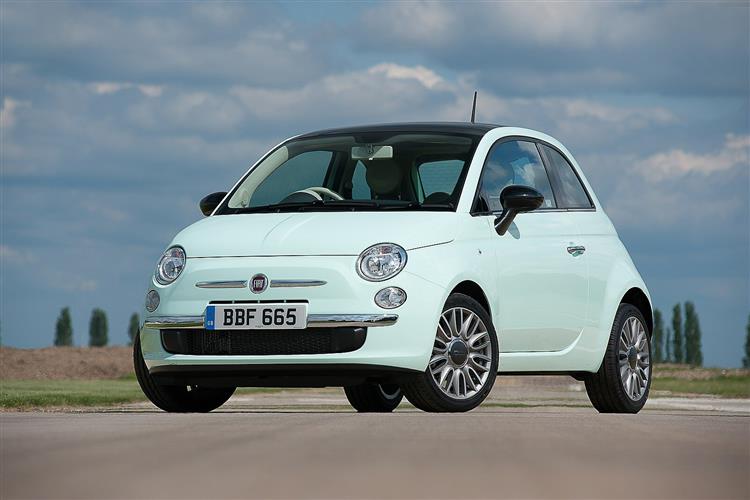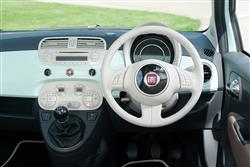GOING FOR AN ITALIAN (some text hidden) --NONE--
By Jonathan Crouch
Introductionword count: 123
Fiat's cheeky little new-era 500 is fun, fashionable and frugal - and the Italian brand has never stopped trying to develop it. After being first launched in 2008, it was updated with TwinAir 0.9-litre petrol turbo power in 2011, then revised again three years later to create the 2014 to 2015 version we're going to examine here as a used buy. The 2014 model year changes brought buyers the option of a pokier 105bhp variant of the petrol TwinAir engine and there was a smarter TFT instrument display on top models, along with a trendy 'Cult' trim level. If you can stretch to a later Fiat 500 model, then it could well be a car from this era that you end up inspecting.
Modelsword count: 14
3dr citycar (0.9, 1.2, 1.4 petrol, 1.3 MultiJet diesel [Pop, Lounge, Colour Therapy, Abarth])
Historyword count: 309
If ever a car has built its brand, it's this one, Fiat's 500. In fact, it's done so twice. First at its original launch back in 1957. And more recently with this modern era version, first launched in 2008. Ever since, it's been a money-spinner for the Italian brand, who've continually developed it, notably in early 2014 when buyers of the more expensive versions got a smarter TFT digital instrument display and the option of a pokier 105bhp version of the clever two cylinder TwinAir petrol engine. These changes kept buyers interested in the range until more widespread changes could be introduced in the Summer of 2015 and it's these 2014 to 2015 era models that we're going to look at here. The flagship 0.9-litre TwinAir 105bhp engine is key to this model's appeal in this period. First, it bridged the previously rather large gap between the standard '500' range and the sporty 1.4-litre turbo 'Abarth 500' models. Secondly, it at last gave Fiat a tool to directly compete with what was probably this car's closest competitor at the time, the MINI Hatch in its most affordable three-door 'MINI One' form. In truth, that rival was actually a slightly bigger car but potential buyers of this Fiat typically tended to consider trying to find the extra money for it. To keep them loyal, this improved post-2014 500 model's smarter cabin and slick TFT digital instrument display was key for the Italian brand's sales people. As before, the 500 model from this period was also available in '500C' guise with an electrically-retracting fabric top. Either way, it offered all the cute, fashionable flair buyers could want - and across most of the range, super-low running costs that, thanks to the clever TwinAir and Multijet technology, easily beat not only those of a MINI but also any conventional little small runabout.
What You Getword count: 791
Who couldn't love a face like this? In developing this car at the turn of the century, the Italian designers took on a big responsibility in seeking to update (and indeed re-size) arguably the cutest shape ever to clothe four wheels. Still, the sustained clamour for this Fiat, in both fixed-top and convertible 500C guises, suggests they got it spot on. This remains a head-turner that makes people smile, not least its driver when it's time to park up. At 1.65m wide, 1.49m high and 3.55m long, this Fiat can fit into spaces that even a MINI would have to avoid. If you choose the 500C variant rather than the fixed-top model we're focusing on here, you get what amounts to a full-length canvas sunroof which electrically retracts into a concertinaed bundle just above the boot. Every 500 model invites a high degree of personalisation via a myriad of colour and trim permutation options but whatever you choose is sure to dovetail deliciously with the very well-judged blend of retro chic and clean contemporary design inside. Delicious details are everywhere, your eyes falling first on the Panda-sourced dashboard with iconic 500 badging that can be specified in the same colour as the body. Before taking in touches like the chrome-ringed vents and the circular head restraints. The steering wheel, adjustable for height but not reach, can feel a little large on first acquaintance and there's a lot to take in from the single circular instrument dial in front of you. That brings us to one of the key improvements made to the updated post-2014 version that we're looking at here, the installation of the segment's first seven-inch TFT digital instrument display. Though with this set-up, the layout out and execution of speedometer, rev counter and trip computer functions will be familiar to anyone who's used to this model, the centre of the display is very different. This contains a neat digital image of the car and can be configured to show various trip computer read-outs, such as distance travelled, instant fuel consumption, range and so on. The TFT display also allows for a more prominent Gear Shift Indicator, highly visible warning messages and a more detailed media player. Plus there are telephone and navigation read-outs including junction graphics and real-time traffic updates if the original new buyer chose to equip the car in question with the optional portable TomTom 2 Live satellite navigation system. As a final touch, the TFT screen reconfigures when the 'Sport' button is activated on models with the 105bhp TwinAir engine. With that, the 'eco' gauge (which measures how efficiently the driver is performing in real time) transforms into a turbo-boost gauge. Once you adjust to the many and varied functions of this set-up, it all works well. And you'll be viewing it from what is generally a comfortable driving position - despite the fact that unfortunately, there's no reach-adjustment for the steering wheel: you can only move it up or down. Bear in mind also that if you go for the optional sunroof, that'll rob you of a bit of headroom. These things apart, only the seat height adjuster, positioned just where the handbrake should be, offers any kind of lasting ergonomic annoyance. The car's certainly been well screwed together in its Polish factory and in-cabin stowage is also well up to par for a citycar. You'll find a usefully deep shelf ahead of the passenger, a small pop-out cubby on the driver's side of the centre console and the usual door bins and cupholders. Even the passenger seat cushion tips forward to reveal an oddments compartment. The only real downside is that the glovebox is simply an open shelf rather than a proper covered compartment. In the back, larger adults will find their heads brushing the roof and will need to make full use of the elbow cut-outs indented into the side panels. Most though, will find the space provided just about sufficient for two people on short to medium journeys. Out back, the boot remains one of the smaller offerings in the segment, though the 185-litre total is still around 15-litres more than you get in rival Toyota Aygo and Vauxhall ADAM models and almost on a par with other city runabouts like Citroen's C1 and Peugeot's 108. What's probably crucial is that the space you get is only 26-litres less than you'd get in a three-door MINI Hatch. It could be bigger though - and the reason we know that is that a Ford Ka (which rides on exactly the same underpinnings as this car) offers you 224-litres. If you need more space, then you can push forward the rear bench, which split-folds in all but the entry-trim level. This frees up 550-litres.
To see the full road test text contact us on 0330 0020 227
Pictures (high res disabled)

.jpg)
|
.jpg)
|
.jpg)
| |||
.jpg)
|
.jpg)
|
.jpg)
| |||

|
Scoring (subset of scores)
Category: Small Runabouts
| Performance | |
| Handling | |
| Comfort | |
| Space | |
| Styling, Build, Value, Equipment, Depreciation, Handling, Insurance and Total scores are available with our full data feed. | |



